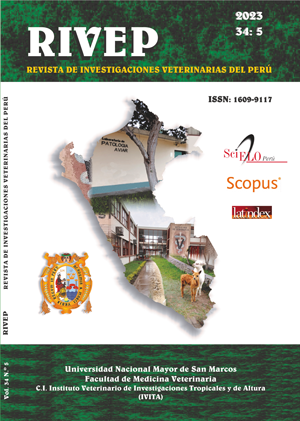Detection of Fasciola hepatica by indirect ELISA in sheep and goats from Boavita, Colombia
DOI:
https://doi.org/10.15381/rivep.v34i5.26378Keywords:
Fasciola hepatica, sheep, goats, indirect ELISA, seroprevalenceAbstract
The aim of this study was to determine the seroprevalence of Fasciola hepatica by indirect ELISA in sheep and goats from Boavita (Boyaca, Colombia). A descriptive cross-sectional study with simple random sampling was carried out. A total of 297 blood samples from sheep and 337 from goats of different breeds and age groups were collected. The sera were analyzed by the indirect ELISA technique with the commercial ELISA kit BIO K 211 - Monoscreen AbELISA F. hepatica. Additionally, an epidemiological survey was carried out. The seroprevalence of F. hepatica was 67.34% (200/297) in sheep and 59.94% (202/337) in goats. Likewise, seroprevalence was higher in males (sheep: 77.78%, 21/27; goats: 63.89%, 23/36), in sheep older than 3 years (83.33%, 50/60) and in goats less than 1 year of age. (69.77%, 60/86), as well as in Creole breed (sheep: 69.84%; goats: 61.79%). Sheep over 3 years of age were determined as a risk factor, while in goats the Creole breed variables and extensive grazing were identified as risk factors.
Downloads
Downloads
Published
Issue
Section
License
Copyright (c) 2023 Sharon E. Cruz- Estupiñan, Diana M. Bulla-Castañeda, Deisy J. Lancheros-Buitrago, Diego J. Garcia-Corredor, Julio C. Giraldo Forero, Martín O. Pulido-Medellín

This work is licensed under a Creative Commons Attribution 4.0 International License.
AUTHORS RETAIN THEIR RIGHTS:
a. Authors retain their trade mark rights and patent, and also on any process or procedure described in the article.
b. Authors retain their right to share, copy, distribute, perform and publicly communicate their article (eg, to place their article in an institutional repository or publish it in a book), with an acknowledgment of its initial publication in the Revista de Investigaciones Veterinarias del Perú (RIVEP).
c. Authors retain theirs right to make a subsequent publication of their work, to use the article or any part thereof (eg a compilation of his papers, lecture notes, thesis, or a book), always indicating the source of publication (the originator of the work, journal, volume, number and date).










